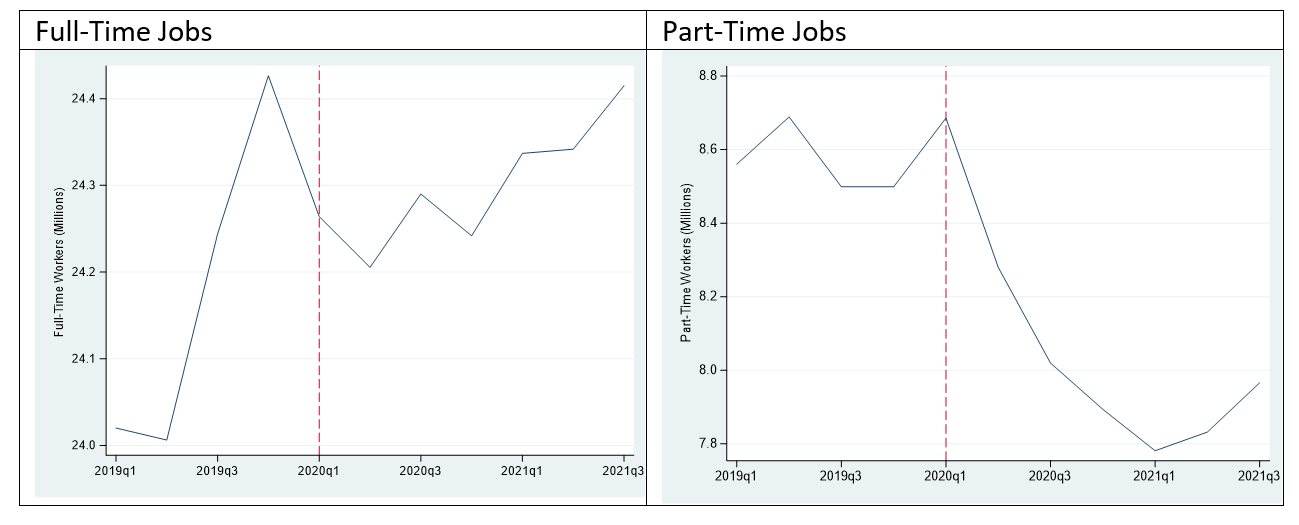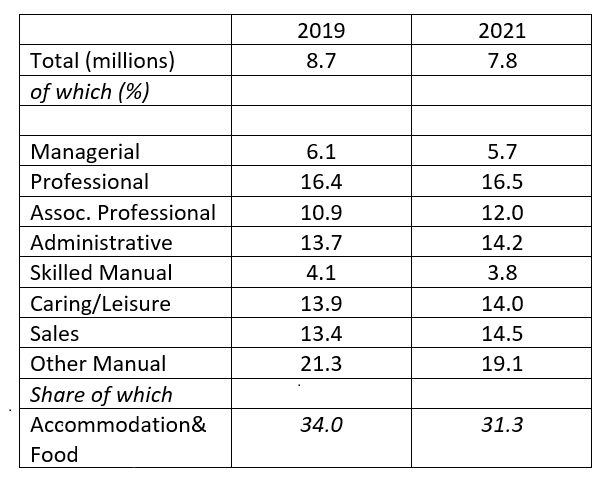As the COVID pandemic reduced or stopped the movement of people, the sectors relying most on demand caused by this movement went into a recession. Part-time jobs in these sectors were hit especially hard. Jonathan Wadsworth writes that it is likely that demand for workers in hard-hit sectors will start to come back, but the persistence of COVID-19 and its associated effects on the movement of people could still slow recovery.
One of the most arresting labour market developments over the course of the pandemic has been the net loss of nearly 1 million jobs. As Figure 1 shows, this loss was experienced almost exclusively among part-time jobs.
Figure 1. Numbers of jobs 2019-2021

Source: Labour Force Survey
While the Figure shows that there is now evidence of a tentative recovery, it seems reasonable to ask what is it about part-time jobs that made some of them so vulnerable in this downturn? We know from past observations that the chances of losing a job are sometimes associated with certain characteristics like age, gender or education. Broadly speaking, the younger you are the more male you are and the fewer qualifications you have the more you are at risk of job loss. Can any of these factors help explain why part-time jobs were at the forefront of job loss in the pandemic?
It is true that most young people in work combine work with full-time study, but workers under the age of 25 account for around 17% of all part-time jobs. Most part-time jobs are held by workers aged 25 and over. We know that younger workers are vulnerable to downturns, but this is unlikely to have accounted for the falling part-time job count. There just aren’t enough younger workers working part-time. Indeed, the share of part-time jobs held by younger workers has remained broadly constant over the downturn
Table 1. Share of part-time jobs

Women make up three quarters of all holders of part-time jobs. Since women in work typically are less at risk of job loss in a downturn, this is unlikely to help explain much of the fall in part-time jobs. Indeed, the share of part-time jobs held by women has remained broadly constant over the pandemic.
One characteristic that does appear to have changed over the pandemic is the share of those in part-time jobs who left school at age 16 which has fallen somewhat. (All these estimates are taken from the Labour Force Survey and so are conditional on the sampling (and weighting) remaining consistent over the pandemic.) Once again, it does seem that having less formal education leaves workers more vulnerable to a downturn and this seems to be related to the type of jobs individuals with less formal education typically work in.
Around two-thirds of part-time jobs pay wages that put them below the income tax threshold and around 40% of part-time jobs pay wages below the threshold for employers to pay National Insurance contributions, (according to the UK Labour Force Survey). In some ways this makes part-time job less expensive for an employer than a full-time job, (two part-time jobs are cheaper than one full-time job). However part-time jobs may not be considered part of the core workforce and so may be more vulnerable in a downturn.
The Figure below shows how the type of part-time jobs changed over the course of the pandemic. The jobs are arranged in order of hourly pay (adjusted for inflation). The higher the bar the greater the fraction of jobs in a pay band. The 2019 distribution of part-time jobs is overlaid by the 2021 distribution of part-time jobs. By comparing the heights of the bars over time we can see how the distribution of part-time jobs by pay shifted over the course of the pandemic. The graph shows that the part-time jobs that disappeared were mostly low paid part-time jobs. This is particularly noticeable in jobs paying between £8 and £10 an hour. Some low paid full-time jobs also disappeared, (right panel), but the changes here were less dramatic. Indeed – unlike for part-time jobs – there was a small rise in the share of full-time jobs paying between £9 to £10 an hour.
It may be that the furlough scheme inadvertently favoured full-time over part-time employees, perhaps because of the requirement for employees to be on payroll at the start of the pandemic, (part-time workers typically have been in a job for less time than full-time workers). More investigation is needed here.
Figure 2. Change in type of part-time jobs during the pandemic

This pattern of job loss is reflected in the changing shares of part-time jobs across broad occupations. As the Table shows, manual part-time jobs in the accommodation and food service sector have taken the largest hit. This was the sector with the largest share of workers on furlough according to HMRC
Table 2. Change in the shares of part-time jobs across broad occupations

Source: Labour Force Survey
Conclusions
Recessions take their toll on jobs. Each recession hits the economy at different places. The COVID-19 induced recession hit the sectors that were most reliant on demand caused by movement of people. The reaction of firms in these sectors was to remove part-time jobs. As the economy begins to recover, it is likely that demand for workers in hard-hit sectors will also start to come back. Indeed, the latest vacancy statistics suggest as much. However, the persistence of COVID-19 and its associated effects on the movement of people could still slow the recovery of part-time jobs in sectors most reliant on mobility.
♣♣♣
Notes:
- This blog post is based on How has Covid-19 affected part-time jobs?, Economic Observatory.
- The post represents the views of its author(s), not the position of LSE Business Review or the London School of Economics.
- Featured image by Louis Hansel on Unsplash
- When you leave a comment, you’re agreeing to our Comment Policy.





